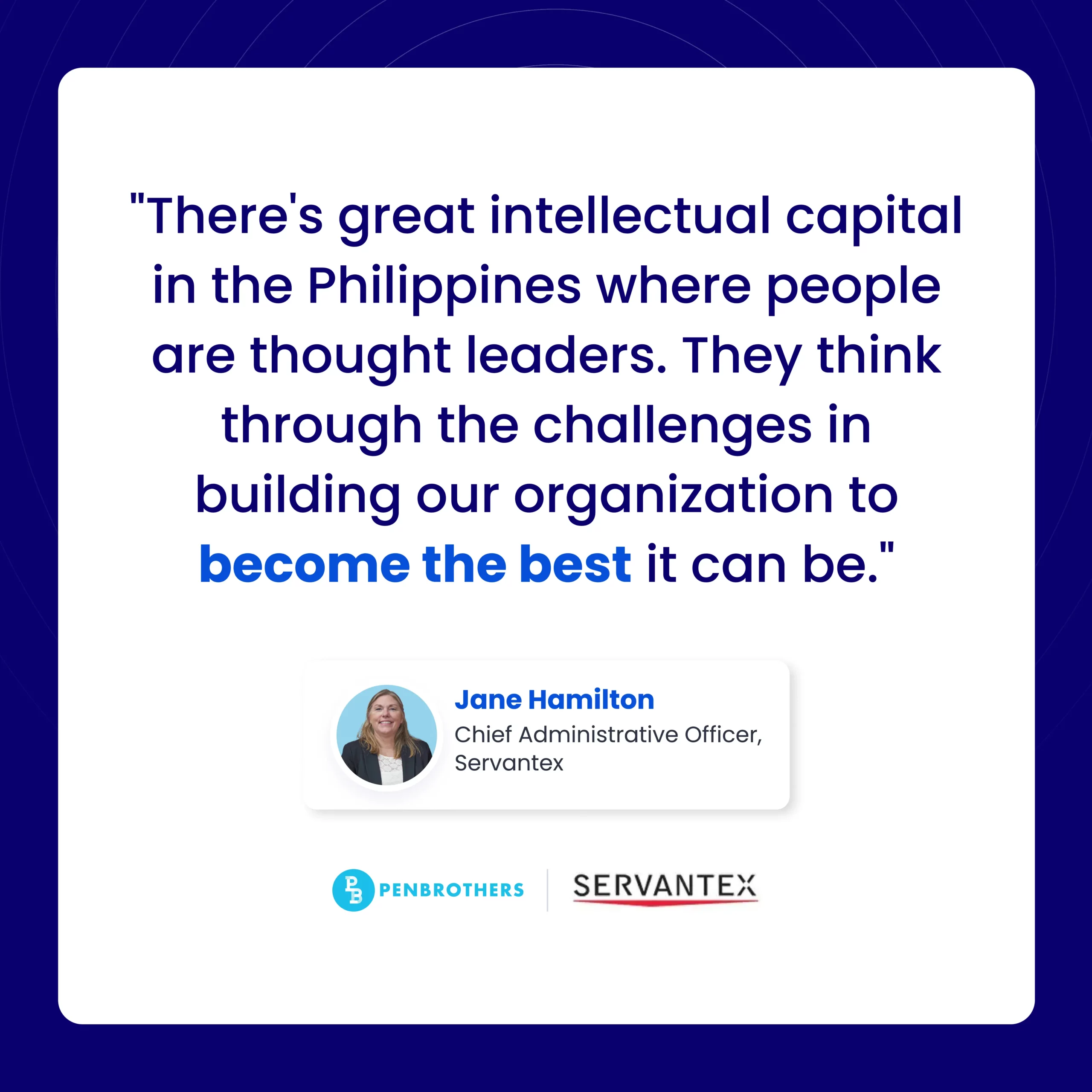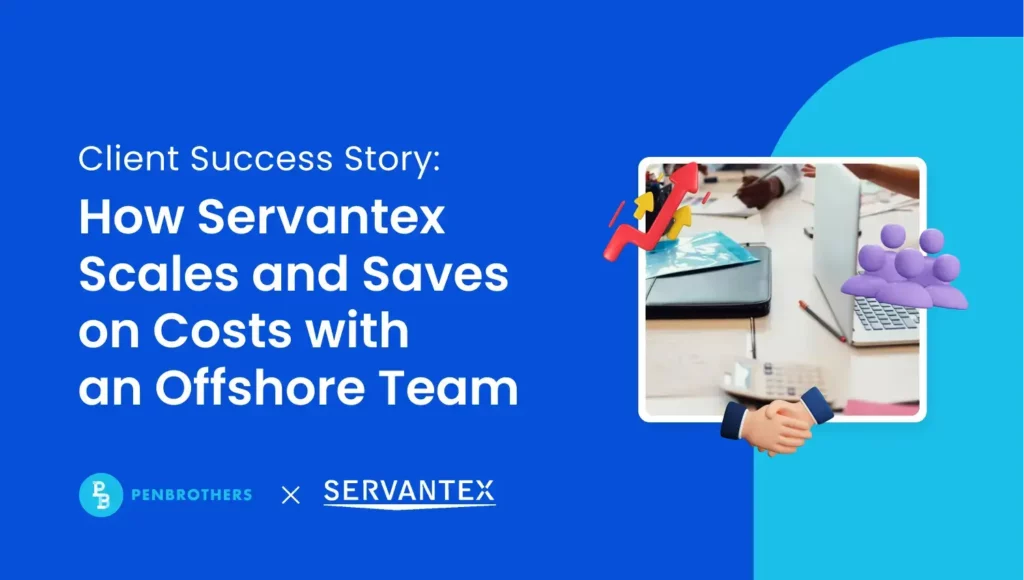The global talent shortage heavily impedes companies and organizations of all sizes. ManpowerGroup reports that 70% of small and medium enterprises (SMEs) face challenges concerning talent shortages.
Costs are skyrocketing because of the complexities of hiring processes. According to the Society for Human Resource Management, the average expense of filling a role in the US is $4,700.
However, Edie Goldberg of US talent management and development company, E.L. Goldberg and Associates, estimates that filling an onshore position has huge costs. Goldberg shared that total expenses may reach up to three to four times more than a position’s salary. For instance, if an accounting specialist has an annual salary of $80,000 in the US, the hiring cost is estimated at $240,000 to $320,000.
Servantex faced these challenges in the workforce management industry. Their business grew post-pandemic, yet they needed internal support for their staff to perform the core roles seamlessly. Because of their needs, they set out to build a remote team in the Philippines. An efficient offshore staff collaborated with Servantex and lowered overall labor expenses.
Discover how Servantex has succeeded in hiring talents and optimizing labor costs.
Servantex: Workforce Management Service
Servantex provides staffing solutions in 25 cities across the United States. With a workforce of over 10,000 associates, they have helped over 600 clients. They focus on the staffing management requirements of companies in multiple industries, such as the hospitality industry.

Companies with multiple branches, hubs, or locations with hundreds or thousands of employees need onsite managers. Since upper management can’t be physically present in multiple locations at once, agencies are usually employed to manage multi-located workforces.
However, using offshoring services of multiple agencies may bloat expenses and decrease direct control. They also aim to avoid inefficiencies in the quality of service.
As a workforce management solution provider, Servantex sends its associates onsite and manages client workforces directly. The hands-on approach allows business owners more access and control over their locations. They can then check the quality of support through measurable factors.
Servantex Faced Scaling and Support Needs
As with many businesses worldwide, the COVID-19 pandemic hit Servantex hard. Their clients were confined to their homes, or at least, their local workplaces. Foot traffic between locations virtually became zero. The hospitality clients shut their hotels down, thus removing the need for Servantex’s services.

Yet, the company bounced back once the pandemic ended, as recounted by Jane Hamilton, Chief Administrative Officer of Servantex. Industries began to reopen and needed the workforce management solutions of the company. Due to the increased demand for their services, Servantex needed to find ways of scaling to support that kind of growth,” Jane shares.
As Servantex grew, they needed a service center team to handle administrative responsibilities. These functions provide support for both their employees and clients. In turn, the offshore team worked on the payroll, billing, tax compliance, and other relevant tasks.
Servantex Chose Offshoring to the Philippines
A Deloitte survey listed the Philippines as one of the best locations for outsourcing. That said, there are several reasons why the Philippines is a viable choice for an offshore team like Servantex’s.
First and foremost is the high English proficiency of Filipino professionals. The Philippines is Top 2 in Southeast Asia and Top 22 out of 111 other countries in English proficiency. These rankings prove Filipino workers are highly qualified for customer support jobs in the US, UK, and Australia.
Second, given the historical intersections between the US and the Philippines, Filipino remote workers are immersed in Western culture. This affinity allows them to easily adapt to the cultures and nuances of the US, UK, and Australia.
Third, remote teams in the Philippines can work at any time of day. For example, US businesses in Pacific Standard Time and Eastern Standard Time thrive because virtual assistants adjust their work schedules to provide reliable services.
Lastly, businesses gain access to a vast pool of talented professionals. More than 1.3 million Filipinos perform online work. These talents perform various roles and functions for organizations in different niches. Servantex saw these advantages to grow its business. It scaled its initial team of one to several members including accounting specialists, service center specialists, and CRM administrators.
Massive Headcount Growth and 79% Cost Savings from Hypercare
Servantex partnered with Penbrothers in hiring remote workers in the Philippines. The talent acquisition strategy is matched with the Hypercare approach.
The latter framework is a consultative and collaborative strategy based on client insights, data, and feedback. Servantex gets an exclusive account manager, onboarding specialist, and 24-hour customer support.
Watch Jane’s video here:
As a result, the strategy fostered a deep understanding of Servantex, its needs, and possible solutions. Customer Success Specialists also ask for post-onboarding feedback to check on hired remote workers and evaluate strategies.
Because of the talent acquisition strategy and the Hypercare process, the total cost of a remote Philippine team is considerably more efficient than an in-house team.
Servantex experienced this firsthand. Because of its offshore service center team, they achieved an average of 79% savings on labor costs per role.
In addition, they have full remote staff support. This support has enabled their US-based workforce to focus on their core functions. Their remote staff in the Philippines focus on their roles and responsibilities for Servantex. All support needed in HR operations like payroll, benefits, and tax compliance is covered.
Offshore Philippine Workers Naturally Shine
Jane shares, “The Philippine culture is one of great politeness. There is this generosity and humbleness. There is great intellectual capital. Filipinos are thought leaders. They will think through the challenges in building our organization to become the best it can be.”
Servantex’s experience with Philippine offshoring services reflects Filipino cultural traits and values that make these remote workers stand out. They have been known to be hardworking, highly adaptable employees.
Despite handling heavy workloads, they continue to be optimistic and compassionate colleagues. They also rise to challenges through resilience and resourcefulness.
Because of Servantex’s positive experience with its remote team, they have expanded their roles beyond the initial one accounting specialist. Their remote Philippine staff has expanded to 31 professionals who provide 24-hour business coverage to their US in-house workforce.
Conquer Scaling and Cost Challenges Through Offshore Philippine Staffing
Talent acquisition challenges could be addressed by offshoring to the Philippines. Servantex has benefited from its offshore Filipino workers through massive cost savings, quality service, and full HR support. Numerous growing companies like Servantex have success stories because of result-oriented offshoring initiatives. Offshoring is a workforce strategy that can be advantageous for labor-scarce companies. Learn how it works, and see how much an offshore team costs through an employee cost calculator guide. Take the lessons from Servantex and others like it.






